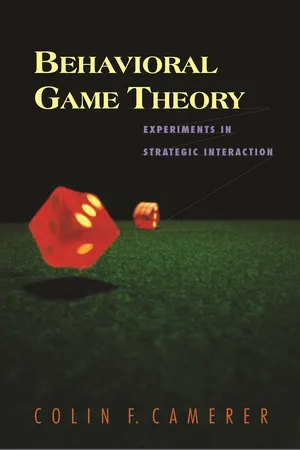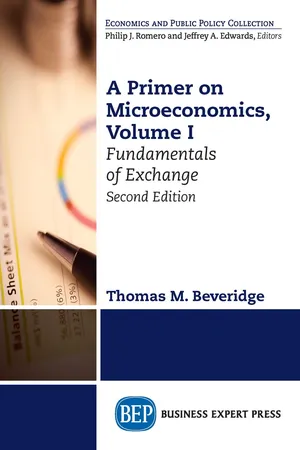Economics
Price Signal
A price signal is a communication tool used in a market economy to convey information about the relative scarcity of goods and services. It is the mechanism by which prices adjust to balance supply and demand, and it helps to allocate resources efficiently.
Written by Perlego with AI-assistance
Related key terms
Related key terms
1 of 4
Related key terms
1 of 3
3 Key excerpts on "Price Signal"
- eBook - ePub
Decision Making in Marketing and Finance
An Interdisciplinary Approach to Solving Complex Organizational Problems
- P. Koku(Author)
- 2014(Publication Date)
- Palgrave Macmillan(Publisher)
CHAPTER 4 Signaling in Finance and MarketingWhat is signaling, why is it used, and when is it used in marketing? These are a few questions that usually come up, which we intend to deal with in this chapter. The term “signaling” is used in many disciplines including, but not limited to, finance, economics, marketing, and evolutionary biology. Some scholars have argued that the term originated from evolutionary biology where scientists use it to describe a unique communication between male and female species—insects, animals, birds, and so on. Signals are different from “cues” and are intentionally emitted by the sender to communicate a specific intent. This intent is received by the receiver of the signal. For example, the male frog communicates its readiness to mate by emitting a specific signal to indicate its intent. This intent is understood by a female gray tree frog that receives the signal (Feldhamer et al., 2007). Similarly, peacocks supposedly signal their reproductive fitness with their large colorful tails (Grafen, 1990).Signaling has, over the years, made its way into other disciplines including those that are not even remotely related to evolutionary biology. In the social sciences such as economics, finance, and marketing, signaling theory is used to explain communication between agents and principals in a market of information asymmetry (imperfect information), in which the market participants have different information. As in evolutionary biology both the signal sender and the receiver benefit from the signal. Spence in a seminal paper on labor market signaling argued that the labor market works more efficiently when potential productive employees signal their productivity through the “amount” of education they have acquired, even if it is assumed that there is no intrinsic value to education itself (1973).Even though the concept of signaling is simple, it is somewhat difficult to fully express in words. This difficulty was expressed by Spence as follows: - eBook - ePub
The Roundtable Series in Behavioral Economics
Experiments in Strategic Interaction
- Colin F. Camerer(Author)
- 2011(Publication Date)
- Princeton University Press(Publisher)
8 Signaling and Reputation In 1974 MICHAEL SPENCE published one of the most influential dissertations ever in economics, which eventually (in 2001) earned him a Nobel Prize (shared with George Akerlof and Joseph Stiglitz, for related work in information economics). Inspired by ideas in international relations, Spence formalized and demonstrated the usefulness of the idea of “signaling.” Signals are actions players take that convey unobservable information about their “types” to other people, who can observe the signals but not the types. Spence had in mind actions that were too costly for people or countries to take unless they were serious, or might be serious. His central example was investing in education to signal intellectual ability (or something). In labor markets, for example, education may signal intelligence (or obedience) to prospective employers. A cheap warranty signals to consumers that a product isn’t likely to break down too often. Giving flowers and small gifts (without the reminder of a splashy holiday such as Valentine’s Day) means you think about her (or him). In organized crime gangs, a person’s willingness to kill or maim a relative who broke the rules signals that they are more loyal to the gang than to their own kin. Signals are credible if they satisfy two properties. First, signals must be affordable by certain types of people, for whom the cost of the signal is less than the benefits that result if the “receiver” decodes the signal. Education pays because it gets students jobs; warranties get firms eager customers; flowers are well worth it if she knows what they mean; and loyalty tests give killers security in their gangs. And, secondly, signals must be too expensive for players of the wrong type to afford. Students who really hate schoolwork cannot stand the pressure and boredom of a very academic university. People selling fake Rolexes from briefcases on the streets of New York cannot afford to offer warranties - eBook - ePub
A Primer on Microeconomics, Second Edition, Volume I
Fundamentals of Exchange
- Thomas M. Beveridge(Author)
- 2018(Publication Date)
- Business Expert Press(Publisher)
Spontaneous order occurs when individuals adjust their actions to signals they observe around them. As you walk across campus, you do not continually collide with those around you. Through observation, body language, and judgment, you can navigate your course safely and effectively. The same behavior is seen in supermarkets—all of the checkout lines at a given time will have a similar number of customers. If a new line is opened, customers will flow toward this new opportunity, but not in limitless numbers. The lines will adjust quickly and again become equal in length. Order is spontaneously restored. Similarly, in the economy, when a new opportunity or challenge opens up, markets operate in a spontaneous but orderly manner to adapt to the new circumstances, reallocating resources and adjusting production.Markets bestow information and incentives. Price, the main signal used in markets, offers information to participants. When the price of a good increases, entrepreneurs are stimulated to make greater efforts to increase production while buyers cast around for other less pricey alternatives. If the price of a resource increases, we would expect suppliers to offer more of it, but we would also expect to see users become more sparing in its use.Markets incentivize producers to sell at the highest price they can receive, but encourage buyers to seek out the lowest price they can find. Firms constantly search for cheaper, more efficient, resources and methods of production while being alert to spontaneous changes in the tastes and preferences of consumers. In resource markets, resources flow to the activity that affords them the highest reward—usually, the activity in which they are the most productive.Resource markets ration our scarce inputs, moving them from low-valued
Index pages curate the most relevant extracts from our library of academic textbooks. They’ve been created using an in-house natural language model (NLM), each adding context and meaning to key research topics.
Explore more topic indexes
Explore more topic indexes
1 of 6
Explore more topic indexes
1 of 4


